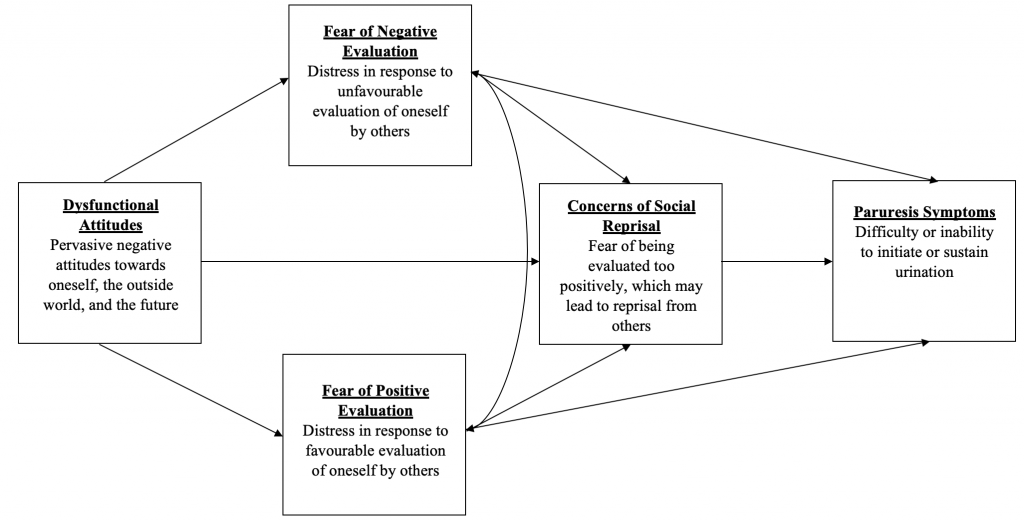Parcopresis and social anxiety disorder
Currently, parcopresis and social anxiety have been noted to contain similar features. Like social anxiety, individuals with parcopresis may experience unhelpful thinking patterns where they fear being negatively evaluated by others, along with avoidance behaviours and coping strategies to reduce the probability and frequency of restroom use. As with social anxiety, parcopresis sufferers may also pay more attention to information indicative of scrutiny or negative evaluation, and expect that others are likely to critically evaluate them (e.g., evaluating sounds or smells).
In 2019 Kuoch, Meyer, Austin, and Knowles undertook a study to explore if an established model of social anxiety (the bivalent fear of evaluation, see HERE) could be adapted and applied to predict parcopresis symptoms. Several psychosocial factors were identified to predict parcopresis symptoms (see below for pictorial presentation of the psychosocial factors found to predict parcopresis symptoms):
- Dysfunctional attitudes (pervasive negative attitudes towards oneself, the outside world, and the future e.g., “I will only be happy if everyone likes me”)
- Fear of negative evaluation (distress in response to unfavourable evaluation of oneself by others e.g., “did you make that smell”)
- Fear of positive evaluation (distress in response to favourable evaluation of oneself by others e.g., “I feel uneasy when I get praise from authority figures”)
- Concerns of social reprisal (fear of being evaluated too positively, which may lead to reprisal from others, e.g., “I get concerned others will ‘put me in my place’”)

Study abstract: Paruresis has been recognized as a subtype of Social Anxiety Disorder (SAD). Awell-established model of SAD is the extended bivalent fear of evaluation model (extended BFOE) which include socio-cognitive processes such as fear of negative and positive evaluation (FNE and FPE), concerns of social reprisal (CSR), and disqualification of positive social outcomes (DPSO). In addition to the extended BFOE, dysfunctional attitudes (DAs) have also been recognized to contribute towards social anxiety symptoms and distress. The aim of this study was to examine whether an extended BFOE model for SAD could be used to explain paruresis and parcopresis symptoms. Three-hundred-and-sixteen undergraduate students (76.6% female; mean age = 31.25 years) completed a cross-sectional online study. A structural equation model (SEM) indicated the data supported the proposed model very well (χ2 p value = .345, CMIN/df = 1.064, CFI = 1.00, TLI = .999, RMSEA = .014, SRMR= .0107) with significant direct relationships being found between DAs and FNE (p = .002), DAs and FPE (p = .002), FNE and CSR (p = .001), FPE and CSR (p = .001), CSR and paruresis score (p = .045), CSR and DAs (p = .006), FPE and paruresis score (p = 001), FPE and parcopresis score (p = .004), FNE and paruresis score (p = .004), and FNE and parcopresis score (p = .002). Although this research should be replicated, the current study provides evidence that DAs, FNE, FPE and CSR are important contributory factors in paruresis and parcopresis symptoms.
